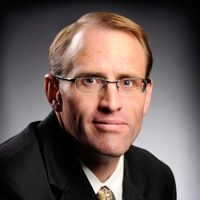When Will the Dow Hit 50,000?
The freight train ride that stocks have taken investors on has many wondering.


The Dow Jones industrial average index (DJIA) opened 2018 just shy of 25,000 on Jan. 2, and a little over two weeks later it already had topped 26,000. I was recently asked when I thought the Dow would reach 30,000. Since stocks are the long-term piece of an investor’s portfolio I think this question misses the mark. The better question is, when will the Dow double to hit 50,000?
First a comment about the index. This DJIA is made up of 30 large-company U.S. stocks. In general, it gives investors a rough idea of how the U.S. stock market is doing. However, since it is composed of only large-company U.S. stocks, it’s really only a good barometer for how large-company U.S. stocks are doing, not all stock categories (small & mid-cap stocks, international stocks, etc.). Because most people are familiar with the index, we often use it to put us in the ballpark when gauging the stock market’s performance.
A ballpark answer: Seven to 10 years
The DJIA needs to rise by 20% to hit 30,000. Another year like 2017 would get us to 30,000. In 2017 the DJIA rose 4,957 points, or 25%. Even if the market’s rise slows, I believe the DJIA will hit 30,000 in the next one to three years, and 50,000 in the next seven to 10 years. If capitalism works, as I believe it does, it wouldn’t be much of a stretch to see this occur. Let's dig deeper.
From just $107.88 $24.99 for Kiplinger Personal Finance
Be a smarter, better informed investor.

Sign up for Kiplinger’s Free Newsletters
Profit and prosper with the best of expert advice on investing, taxes, retirement, personal finance and more - straight to your e-mail.
Profit and prosper with the best of expert advice - straight to your e-mail.
For a moment let's ignore the economy, the geopolitical landscape and fiscal policy and just focus on the simple math at hand. Let's review the “Rule of 72.” The Rule of 72 is a way to determine how long it will take for an investment to double in value. Here is how it works. Simply take an investment’s growth rate and divide it into the number 72. The result equals the length of time it will take your money, or in our case, the index, to double.
For example, the DJIA has enjoyed an annualized increase of 7.33% since 1950, based on Yahoo Finance historical data. If we divide 72 by the number 7.33 (our historic annual rate of return) we get 9.82. So, at a 7.33% annualized increase the DJIA will double every 10 years (9.82 years, to be exact). If we continue at our 1950-2017 pace, the DJIA index will double, or hit 50,000, in 10 years.
Your investments could grow even faster than Dow
Although the DJIA may take 10 years to double, the money you invest in DJIA stocks should double faster than that. Remember, the DJIA measures stock price changes. It does not also include the dividends DJIA stocks pay. Currently, the DJIA stocks pay about a 2% dividend, according to Yahoo Finance. For example, if you bought into the DJIA by investing $10,000 into the SPDR Dow Jones Industrial Average Index ETF (Symbol: DIA) from 2008-2017 it would have grown to $23,967 if you had dividends reinvested, and only $18,670 without reinvested dividends.*
What are the chances the DJIA will double in the next 10 years? To answer this question I looked back and measured each 10-year period from post-World War II until now.** Out of 64 10-year periods, the index doubled in 31 of them, or about half of the time (48%). The best 10-year period ended in 1998, providing a 10-year annualized return of 15.5%, while the worst 10-year period ended in 1974, producing a negative 3.4% annualized return. Of course, past average performance (7.33%) is no guarantee of future results. There has been a major variation depending on the time period you measure. The longer you have to invest, the more likely you are to have a better average return.
The bottom line for investors
I like to look at stocks as my long-term money (money I don’t plan on spending for 10 or more years.) Consequently, I am not really concerned about where the DJIA Index is in two to three years, or when it may hit 30,000, but rather where it will be in 10 years or beyond. Because I believe capitalism will continue to work, I believe companies will continue to make money and stocks will continue to rise. If the DJIA index continues at its average 1950-2017 rate, it will reach the 50,000 mark sometime around 2027-28.
*Morningstar Office
**The first rolling 10-year period measured was from 1945-1954
Profit and prosper with the best of Kiplinger's advice on investing, taxes, retirement, personal finance and much more. Delivered daily. Enter your email in the box and click Sign Me Up.

Ray LeVitre is an independent fee-only Certified Financial Adviser with over 20 years of financial services experience. In addition he is the founder of Net Worth Advisory Group and the author of "20 Retirement Decisions You Need to Make Right Now."
-
 Stocks Rally as Investors Buy the Dip: Stock Market Today
Stocks Rally as Investors Buy the Dip: Stock Market TodayMost sectors are "go" only a day after talk of bubbles, extended valuations and narrow breadth undermined any kind of exuberance.
-
 Elon Musk's $1 Trillion Pay Package Vote: What's at Stake for Tesla Stock
Elon Musk's $1 Trillion Pay Package Vote: What's at Stake for Tesla StockTesla shareholders are voting this week on a massive pay package for CEO Elon Musk. Here's what it means for the Mag 7 stock.
-
 Stocks Rally as Investors Buy the Dip: Stock Market Today
Stocks Rally as Investors Buy the Dip: Stock Market TodayMost sectors are "go" only a day after talk of bubbles, extended valuations and narrow breadth undermined any kind of exuberance.
-
 I'm a Financial Planner: This Is Why Commitment, Not Perfection, Drives Financial Success
I'm a Financial Planner: This Is Why Commitment, Not Perfection, Drives Financial SuccessMeeting your goals is more likely if you stick to your strategy despite market volatility and scary headlines. Consistency makes a difference.
-
 I'm a Financial Professional: This Is Why Now Is the Time for Investors to Look Abroad
I'm a Financial Professional: This Is Why Now Is the Time for Investors to Look AbroadExtreme U.S. market concentration has made international equities not just a diversification play, but a timely opportunity.
-
 Four Ways to Make the Most of Your Benefits During Open Enrollment
Four Ways to Make the Most of Your Benefits During Open EnrollmentOpen enrollment is a chance to make sure you're getting every ounce of value from your workplace benefits and on track to reach your long-term financial goals.
-
 Stocks Retreat as Bubble Worries Ramp Up: Stock Market Today
Stocks Retreat as Bubble Worries Ramp Up: Stock Market TodayValuation concerns took hold on Wall Street today, sending Palantir and its fellow tech stocks lower.
-
 Your Estate Plan Isn't 'Done' Until You've Completed These Five Steps, From an Estate Planning Attorney
Your Estate Plan Isn't 'Done' Until You've Completed These Five Steps, From an Estate Planning AttorneyCongratulations on getting your estate plan in order. Now, you need to communicate the relevant details to ensure your plan is effectively carried out.
-
 A Nightmare for Parents: How to Navigate the Legal Boundaries of Tenant Rights During a Family Crisis
A Nightmare for Parents: How to Navigate the Legal Boundaries of Tenant Rights During a Family CrisisThis family's story illustrates how important it is to get help sooner rather than later and highlights the complexities of tenant rights and legal protections.
-
 Amazon Surge Sends S&P 500, Nasdaq Higher to Start November: Stock Market Today
Amazon Surge Sends S&P 500, Nasdaq Higher to Start November: Stock Market TodayAmazon inked a $38 billion cloud deal with OpenAI, which sent the stock to the top of the Dow Jones on Monday.